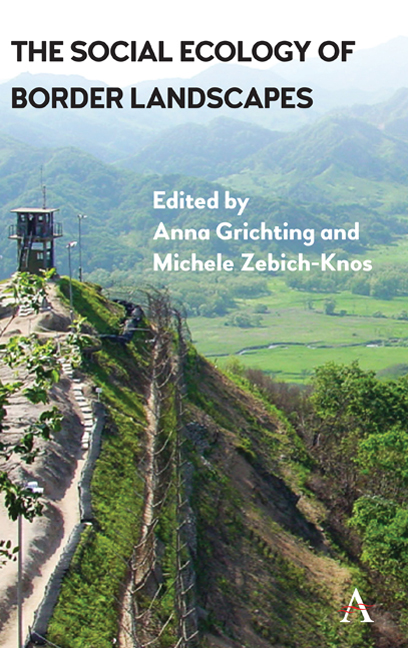Book contents
- Frontmatter
- Contents
- List of Illustrations
- Preface
- List of Contributors
- Introduction: Social Ecologies and Borderlands
- Part I FRAMES: MAPPING SOCIAL ECOLOGIES IN BORDER TERRITORIES
- Part II BRIDGES: RESILIENCE, RESTORATION AND RECLAMATION
- Part III CORRIDORS: CATALYSTS AND COLLABORATION IN CONFINED SPACES
- Part IV PORTALS: DIALOGUE, EXCEPTION AND RETERRITORIALIZATION
- Conclusion: Making Sense of Social Ecology, Borders and the Environment
- Index
Conclusion: Making Sense of Social Ecology, Borders and the Environment
Published online by Cambridge University Press: 10 January 2018
- Frontmatter
- Contents
- List of Illustrations
- Preface
- List of Contributors
- Introduction: Social Ecologies and Borderlands
- Part I FRAMES: MAPPING SOCIAL ECOLOGIES IN BORDER TERRITORIES
- Part II BRIDGES: RESILIENCE, RESTORATION AND RECLAMATION
- Part III CORRIDORS: CATALYSTS AND COLLABORATION IN CONFINED SPACES
- Part IV PORTALS: DIALOGUE, EXCEPTION AND RETERRITORIALIZATION
- Conclusion: Making Sense of Social Ecology, Borders and the Environment
- Index
Summary
Borders, Culture and Equity
One lesson that this rich array of chapters conveys is that borders are not only physical divisions between nation-states (or states), but are also lines of separation between peoples, places, things and even mindsets. These lines of separation occur tangibly between and within states, and intangibly within one's own psyche. Put simply, borders (also referred to as frontiers) define the difference between us and them, whether they are physical barriers such as the Israeli-constructed wall surrounding Palestinian territory, or psychological barriers resulting from years of political turmoil between Protestants and Catholics in Belfast, Northern Ireland. Brunet-Jailly argues that, since 9/ 11, the notion of an increasingly securitized border is a familiar mainstay between states, yet also extends from the periphery (territorial border) to the core (state's heartland) via airports, pre-clearance areas and other security-check locations. Brunet-Jailly emphasizes the “non-territorial border” that, in turn, broadens the concept of border space and gives it a new and more fluid meaning. The non-territorial border transforms into a “third space” that, according to Konrad and Nicol, is “occupied by heterogeneous and hybrid culture, with […] people who share new visions of community across borders.” It is a space in which culture plays a key role in explaining how a landscape emerges socially, environmentally and politically. One might even liken Konrad and Nicol's third space to that of Cunningham's edge effect resulting in the intersection of two bordering communities.
It is in that intersection that a hybrid culture can develop. The intersection of two cultures may indeed manifest “new visions of community” and apply, for example, to Belfast, Northern Ireland, where Murtagh admits to the decrease of housing segregation and the increase of “ethno-religious mixed housing.” Yet, following the 1998 Belfast Peace Agreement, he also recognizes the increase of “peace lines” that separate Protestants and Catholic communities. Such lines foster a newly securitized Belfast in keeping with Brunet-Jailly's assertions in Chapter 1; and, one might question how that contributes to a new vision of community in Belfast.
- Type
- Chapter
- Information
- The Social Ecology of Border Landscapes , pp. 243 - 254Publisher: Anthem PressPrint publication year: 2017

